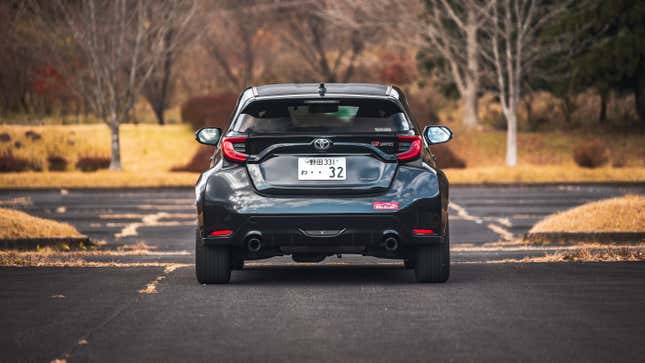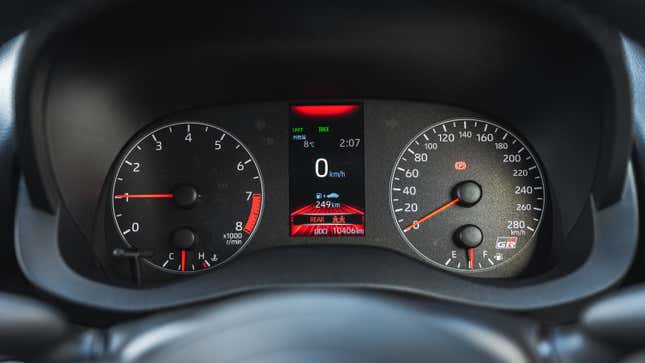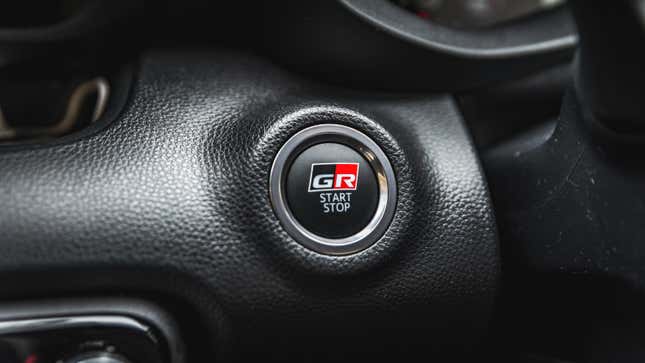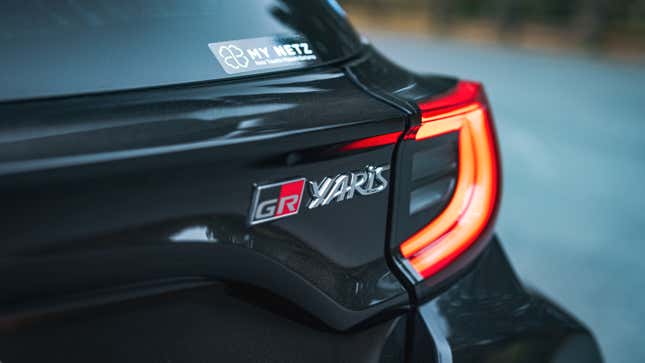The Toyota GR Yaris — better known to devoted fans of the type as the Yaris GR4 — has been more universally hyped in recent times than any other car, in such demand I couldn’t even borrow a press-fleet car yet. To test Toyota’s homologation hot hatch, this street-legal version of a rally car that’s never actually going to compete in the World Rally Championship, I found one in a rental fleet and jumped at it.
So, is the GR Yaris worth all the hype?
The awesome guys at Omoshiro Rental Cars (you may remember them from the Honda Civic Type R FD2 they lent me a couple years ago) offered to lend me one of the two cars they have to scratch my GR itch. The black car I drove was the RZ trim, which does without the RZ High Performance trim’s Torsen LSD, Michelin Pilot Sport 4 tires and has different suspension tuning. Think of this one as the “comfort” version.



Driving
I can’t recall the last time the drive modes in a car so drastically affected the way it behaved as much as it did in the GR. In default Normal mode, the torque split is 60:40, like it would be in any normal front-biased 4WD hot hatch. It’s fairly conventional in this mode, feeling more like a very well-sorted FF hatchback. The closest I can compare it to in this mode is a Renault Mégane R.S. Trophy, another hot hatch you can’t get in the U.S. Trust me, that’s high praise. The Mégane is a more exciting and manic front-drive hot hatch than the Civic Type R, and this is how the Yaris feels in its normal mode.
Turn the dial left for Sport mode and it transforms completely. Some cars demand your attention at all times; others don’t need you to do anything except sit there and steer. The GR4 is constantly up for fun in this setting. Torque split is now 30 percent to the front and a hilarious 70 percent to the rear. Yes, that makes this a rear-biased hot hatch.



It’s playful and constantly egging you on to keep pushing it. What I loved most was that in any of its modes, the turn-in is always direct and crisp. It dives into the apex and clings while the rear end pivots around like it’s attached to your hips. I love the hula-hoop feeling as it goes around corners in a way similar to an Alpine A110 or Mazda MX-5. This is excitable puppy mode.
But don’t mistake that for being prone to snapping. It doesn’t. On tighter corners, even with most of the power going to the back, it corners in a neutral manner. It’s only when you fool around with the pedal on the right that the back will pivot ever so slightly away from the corner. Should you be feeling brave, you can switch off the driver aids, engaging Expert Mode, and have the back swing out full rally style. I didn’t take my brave pills that day so ESP was left on.
In Track mode the torque is split 50:50. I know this is a cliché, but it really did go around corners like a smaller Nissan GT-R, where you could just power out without a care in the world. The way it ate up corners was astonishing for such a small car. What I loved most about this car was its ability to always make me smile. It was so cheerful and charismatic, which is something we all need after this year. This is alert puppy mode.




So it’s great around corners and on a mountain road, but what about everything else? Well the 1.6-litre three-cylinder turbocharged engine is a peach. JDM-spec cars get 272 horsepower, and for some reason overseas cars get only 265 HP. Torque is rated at 265 lb-ft and it all comes at above 3,000 rpm.
Below 3,000 rpm, there’s not much there. I don’t mind that because this engine loves to rev, and unlike many turbo units you can keep pushing it to its redline and it doesn’t seem to run out of puff. I just wish it sounded a bit more enthusiastic. Sure, inside you get some noise fed to you via the speakers, but from the outside it just sounds like some noise.
The manual gearbox is a delight to use. It feels tactile and mechanical, and like the engine and chassis, it feels tight and purposeful. It’s not quite as slick to use as the kit in the Civic Type R’s but it’s close. I do appreciate that Toyota has raised the gear lever so your hand falls on it perfectly, though a central armrest would’ve been nice too.
How Toyota Is It?
During the time I had Omoren’s GR, I took it to two different mountain roads two hour’s drive from Tokyo. By the time I gave it back I had covered around 500 miles and I didn’t feel broken or in pain from the ride. Toyota got the balance of this car just right, so I’m even more curious to see how the High Performance spec car with a stiffer set up and LSD will feel like.
Sure it’s called a Yaris but really the only thing it shares with the normal model are the headlights, taillights and antenna. Everything else is bespoke, including the new three-door body. Around town it’s as easy to drive as any other Toyota hatchback, and the ride in this RZ spec is firm but never uncomfortable.
The large central display screen and low position of the rear view mirror hinders visibility as does the C-pillar. The speakers are quite bad, and there’s not much headroom in the back thanks to the sloping roof. The trunk space is also limited. It can still do all the other normal stuff well though, and it is still a Toyota after all.



Hype-worthy?
The FK8 is a more complete hot hatch, but the GR will put a bigger smile on your face. That’s really down to the car’s character, or rather multiple characters.
I imagine the hype will eventually die down, just as it did with the Supra and most other sports cars from recent years. Those left with a GR Yaris still have a car that’s a riot to drive, that’ll make them smile day-in and day-out, on any road in any condition.
I love this car. I love the way it goes and the way it makes me feel and what it represents. It’s like a Mercedes CLK GTR, sharing nothing with the mainstream model apart from the name and lights. It’s like the Ferrari 288 GTO, in that it’s a road car that was made to homologate a rally car that never competed, and like the Lexus LFA it shows what Toyota (and Japan) can do when passionate leadership throws resources into something exciting. The GR Yaris is not only a return to form for Toyota’s golden age of affordable performance cars. It’s a testament to Akio Toyoda’s mission on making Toyota’s cars more fun.
The GR deserves all the hype and praise it’s getting. Now I hope it gets the attention of other Japanese manufacturers to come out with exciting, affordable and ruthlessly engineered cars to finish off the era of the internal combustion engine on a high.

